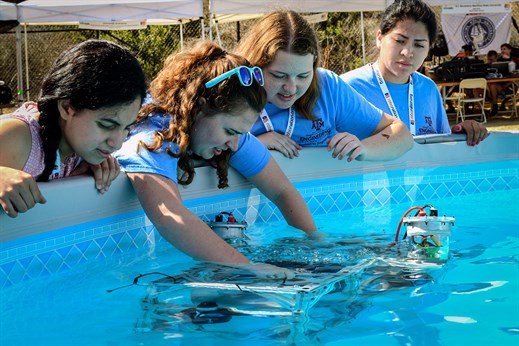Nine engineering students supported by the Women in Engineering (WE) program at Texas A&M University competed in the 2016 International RoboSub Competition in San Diego. Their mission was to earn the highest number of points completing a series of underwater tasks with a RoboSub they designed and programmed themselves. In the end, the Texas A&M team, WE REAF, made it to the semifinals.

“The Women in Engineering project teams give students a chance to learn from the ground up in a real-world setting,” said Shawna Fletcher, director of Women in Engineering. “Project teams exist around campus, but some women shy away from these experiences. WE provides a technical opportunity where students can design, build, program and test Autonomous Underwater Vehicles (AUV) and other projects in a safe space where it’s OK to learn and make mistakes.”
Fletcher said the students often join the teams with little knowledge, but leave with expertise because they are able to challenge themselves and learn from each other in a welcoming environment. The team used the Engineering Innovation Center at Texas A&M to work on its robot, spending months to design and build a cost-efficient RoboSub.
Learning & collaborating
Judy Amanor-Boadu, an electrical engineering Ph.D. student, served as a graduate mentor to the team. Amanor-Boadu said she enjoyed the collaborative environment the competition provided, saying it wasn’t about who got first place, but instead it was about solving problems.
“It’s more about sharing information and growing each other,” she said, adding that she would have benefited from an opportunity like this when she was earning her undergraduate degree.
Sarah Beardsley, a junior computer science major, said the project team provided her with a wealth of information that helped in her classes.
“I’ve lost track of the number of times I was researching something for the project and realized, ‘Wait a second, this ties in to that lecture in my engineering class last week,’” she said. “The lessons I learned that I consider to be the most important to me were more related to project management and leadership.”
The payoff
The team was divided into three sub-teams — programming, electrical and mechanical. All were put to the test when the thrusters on the team’s RoboSub stopped working after they arrived in San Diego. After speaking with other teams who had the same thrusters, the Texas A&M team learned it was a manufacturing error. The company that made the thrusters provided each team with a different model.
“The new thrusters they gave us were completely different, so it’s not just like plug and play,” Amanor-Boadu said. “The company came on Friday and we had until Saturday to make sure we were done.”
The team stayed up all night, cutting wires, redesigning and reprogramming its robot, making sure it was watertight. In the end, the team learned about the importance of collaboration.
“Finally, at about 4 a.m., the new thrusters were ready to go, so we took our robot down to the hotel pool to test it,” Beardsley said. “To our excitement, the new thrusters worked.”
The team’s hard work paid off the next day when WE REAF made it to the semifinal round.
“When our robot finished the qualifying task, the team cheered so loudly that other competitors told us later that they could hear us cheering from the other side of the facility,” Beardsley said. “When we first started the project last fall, the goal we had set for ourselves for our first year was to make it to the semifinal round, so reaching that goal felt like all of the hard work that myself and my teammates had put into the project had finally paid off.”
While there were other women represented in the 46 teams at the competition, WE REAF was the only all-female team, becoming the first of its kind in the competition’s 19-year history.